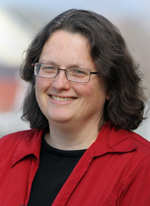|
As a Southerner
by birth but a recent transplant
from Minnesota, I welcomed trading
blizzards for palm trees when I
accepted the position of managing
editor of "Progress Notes." I
think it only fitting that the
February issue, the first issue I
have written, features an
alligator on the cover — a tribute
to my new Lowcountry home.
 Kimberly McGhee Kimberly McGhee
This column
will cover highlights from
"Progress Notes," a bimonthly
publication for doctors that
covers the clinical innovations
and exciting research under way
here that could revolutionize the
medicine of tomorrow. It's why
there's an alligator on the cover
as a tribute to the work of Louis
Guillette Jr., Ph.D., who studies
how environmental pollutants
affect human reproductive health
by monitoring changes caused by
them in wildlife, such as the
alligator.
Alligators,
like canaries in a mine, alert us
to a danger in the local
environment. Guillette has
documented underdevelopment or
malformation of alligator
reproductive organs that can be
traced back to exposure to
environmental toxins, such as
those that can be traced to
pesticides, plastics, industrial
solvents, and personal care
products like lotions and
shampoos.
His findings
have led him to believe that many
diseases or disorders found in
adult women, such as endometriosis
or uterine fibroids, can be traced
back to environmental exposure to
toxins as well.
Also covered in
this issue is the research being
done at the new Bioengineering
Building. The work of these
researchers is quickly blurring
the lines between science fiction
and scientific fact.
Take, for
example, the tissue-based
pacemaker being developed by
Martin Morad, Ph.D. When I think
of a pacemaker, I see a
battery-operated device that is
put in a patient, must be replaced
every so often, and sets off
airport scanners.
The pacemaker Morad hopes to
develop, on the other hand, would
never need replacing. It could
change the heart rate to meet the
body's changing needs (for
example, speeding it up for
jogging). One of the best features
is that it would introduce nothing
foreign into the body. A patient's
own skin cells would be
transformed into cells known as
induced pluripotent stem cells and
then developed into cardiac cells
that could be injected into the
heart to naturally control its
pacing.
Another
fascinating area is the regrowth
of brain or spinal tissue after
serious injury, a feat once
thought impossible. Celebrities
like Superman actor Christopher
Reeve have drawn attention to the
need to encourage cutting-edge
research into tissue regeneration.
The number of soldiers returning
from Iraq and Afghanistan with
traumatic brain injuries makes
that need more pressing than ever.
Xuejun Wen,
M.D., Ph.D., and Ning Zhang,
Ph.D., of the Clemson-MUSC
Bioengineering Program, have found
a way to promote the regrowth of
brain tissue. Wen and Zhang have
developed a hydrogel — a liquid
that becomes gelatinous after
being administered — that can be
injected into the empty cavity in
the brain left by a stroke or
traumatic brain injury. The
hydrogel provides a base on which
blood vessels can regrow, the
first step in regrowing brain
tissue. Such hydrogels may one day
restore function to those with
brain and spinal cord injury.
Another area of
research offering hope is the work
being done by the Center for
Biomedical Imaging, headed by
Joseph A. Helpern, Ph.D. Many fear
one day developing Alzheimer's
disease or dementia, but right now
there is no way to know who is
more likely to do so. Helpern's
group uses new imaging techniques
to search for early, tiny changes
in brain tissue that predict who
will develop such diseases. Early
detection could one day mean
earlier, more effective treatment.
To read more
about the work of bioengineers as
well as other clinical and
research innovations at MUSC,
visit the February issue of
"Progress Notes," available at MUSChealth.com/progressnotes.
Editor's
note: "Progress
Notes" is a bimonthly
publication produced by Business
Development & Marketing
Services and sent to all
physicians licensed in South
Carolina to inform them about
clinical and research
innovations at MUSC.
|



